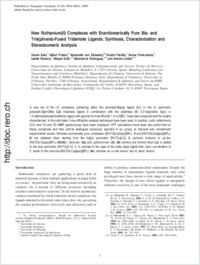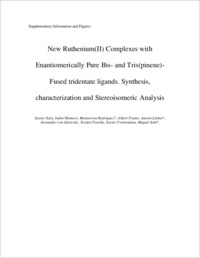New ruthenium(II) complexes with enantiomerically pure bis- and tris(pinene)-fused tridentate ligands: synthesis, characterization and stereoisomeric analysis
- Sala, Xavier Departament de Química, Institut de Química Computacional, and Serveis Tecnics de Recerca, Universitat de Girona, Spain
- Poater, Albert Modeling Laboratory for Nanostructures and Catalysis, Dipartimento di Chimica, Università di Salerno, Italy
- Zelewsky, Alexander von Department of Chemistry, University of Fribourg, Switzerland
- Parella, Teodor Departament de Química and Servei de RMN, Universitat Autònoma de Barcelona, Spain
- Fontrodona, Xavier Departament de Química, Institut de Química Computacional, and Serveis Tecnics de Recerca, Universitat de Girona, Spain
- Romero, Isabel Departament de Química, Institut de Química Computacional, and Serveis Tecnics de Recerca, Universitat de Girona, Spain
- Solà, Miquel Departament de Química, Institut de Química Computacional, and Serveis Tecnics de Recerca, Universitat de Girona, Spain
- Rodríguez, Montserrat Departament de Química, Institut de Química Computacional, and Serveis Tecnics de Recerca, Universitat de Girona, Spain
- Llobet, Antoni Departament de Química and Servei de RMN, Universitat Autònoma de Barcelona, Spain - Institut Català d’Investigació Química, Tarragona, Spain
-
2008
Published in:
- Inorganic Chemistry. - 2008, vol. 47, no. 18, p. 8016–8024
English
A new set of Ru−Cl complexes containing either the pinene[5,6]bpea ligand (L1) or the C₃ symmetric pinene[4,5]tpmOMe (L2) tridentate ligand in combination with the bidentate (B) 2,2′-bipyridine (bpy) or 1,2-diphenylphosphinoethane (dppe) with general formula [RuCl(L1 or L2)(B)]⁺ have been prepared and thoroughly characterized. In the solid state, X-ray diffraction analysis techniques have been used. In solution, cyclic voltammetry (CV) and 1D and 2D NMR spectroscopy have been employed. DFT calculations have been also performed on these complexes and their achiral analogues previously reported in our group, to interpret and complement experimental results. Whereas isomerically pure complexes ([RuIICl(L2)(bpy)](BF₄), 5 and [RuIICl(L2)(dppe)](BF₄), 6) are obtained when starting from the highly symmetric [RuIIICl₃(L2)], 2, isomeric mixtures of cis,fac-[RuIICl(L1)(bpy)](BF₄) (3b/3b′), trans,fac- (3a) and up/down,mer- (3c, 3d) isomers are formed when bpy is added to the less symmetric [RuIIICl₃(L1)], 1, in contrast to the case of the bulky dppe ligand that, upon coordination to 1, leads to the trans,fac-[RuIICl(L1)(dppe)](BF₄) (4a) complex as a sole isomer due to steric factors.
- Faculty
- Faculté des sciences et de médecine
- Department
- Département de Chimie
- Language
-
- English
- Classification
- Chemistry
- License
-
License undefined
- Identifiers
-
- RERO DOC 11288
- DOI 10.1021/ic800252f
- Persistent URL
- https://folia.unifr.ch/unifr/documents/301075
Other files
Statistics
Document views: 101
File downloads:
- pdf: 240
- Supplementary material: 205
- Supplementary material: 108


